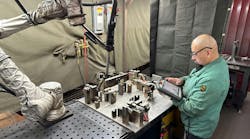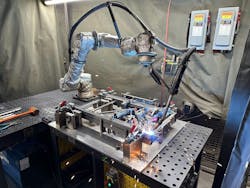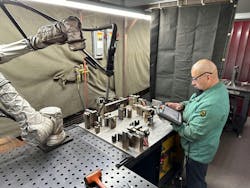Manufacturers face a quintuple-whammy: the need to improve productivity; fight cost pressures; boost quality and repeatability; build a more robust supply chain (e.g., via reshoring); and fill 82,500 welding jobs annually between 2024 and 2028.
Not to sound the alarm, but American companies need to get into automation quickly. The good news is that everyone is in the same boat. Automation technology is democratic; it is open to everyone. Success comes when companies create a culture that embraces automation, sets itself up for success and proceeds wisely.
RELATED: Entrenched in Robotics: An On-the-Go Conversation with Jan Hennecke
RELATED: High-Value Robotics Trends and Technologies
So that welding experts can learn from their peers, the American Welding Society (AWS) holds automation-related educational events, such as the AWS Welding Automation Expo & Conference held late last year. Following are 10 key takeaways from presenters at the conference:
- Last Arrow Manufacturing has 12 cobots. In one example, using a cobot took production time from 75 min. down to 24 min. “Automation has been a key to reducing our overhead because everybody wants a price reduction, but health insurance, workers’ comp, all those things are just continually increasing with no help in sight on any of that.”—Matt Bowling, president, Last Arrow Manufacturing
- “A little programming hack: Always use new consumables and check your Tool Center Point beforehand. I also program a few welds and run those welds just in case there’s any distortion, or anything that’s moving, just to verify programming.”—Marvin Hererra, CWI, CWE, welding engineer, Freedman Seating Company.
- “Cobots with modular fixturing tables work well. We have a team and machine shop dedicated to making fixtures. Notice we designed this fixture on a large plate with locating holes, so if we want to weld a different part, we quickly take off one fixture and put another on.”—Marvin Hererra, CWI, CWE, welding engineer, Freedman Seating Company.
- “We use the cobot not just for welding, but to tack up the components if we created a fixture where the threadolet [pipe fitting] was held in place. We can come in there and apply our sacrificial bridge tack. This also helps with distortion control because those things are predictable. An interesting conversation that we’ve been having is, why not have a cobot upstream from a traditional cell where now you’re not doing so much hard fixturing?”—Corey Mays, CWI, president, CM Welding and Machine, Inc.
- A presenter from Vermeer, a global manufacturer of industrial and agricultural machines, shared lessons related to implementing collaborative robots. They noted that successful implementation is all about messaging. They built a collaborative environment where employees had buy-in to automation and were part of that automation process so they would understand that automating isn’t about replacing jobs; it’s about being competitive in a market. The second lesson shared was not just to invest in new technology, but also to invest in people, which is part of the Vermeer philosophy.
- Three keys to successful automation include ownership (especially for programming), line balancing (so you don’t just move a bottleneck) and creativity. “Creativity can be found when people are equipped to succeed and then allowed the time to do it. Very few people are going to be instantaneously creative and successful in continuously high-pressure situations.”—Joseph Russell, senior manager of Welding Engineering and Continuous Improvement, Arcosa
- “What makes the Precision Power Laser (PPL) process different is that instead of using a very focused beam, we’re widening up the beam. We’re super heating the wire so that by the time it enters the laser light, it flows right in, melts and solidifies almost instantly as soon as it exits the puddle. It is a very fast process and very smooth, with no arc. You want it to be kind of boring, smooth and very clean, right? It’s not an exciting bright arc throwing spatter everywhere.”—Elliott Ash, welding engineer – Laser Applications, Lincoln Electric
- “I said get a pick-and-place robot. Let’s improve our efficiencies. My boss laughed at me. He said, ‘You’re going to have to sell that to corporate.’ To sell automation to your boss, use the DMAIC process: Define, Measure, Analyze, Improve and Control. This five-step process will solidify every automation sale.”—Joe Wallace, welding engineer, Matheson Tri-Gas
- “Understand what your part tolerances are, especially the sub-assemblies as they grow into full assemblies. Parts tolerance stack up can be a huge problem with automation. We also talked about repeatability versus accuracy. How difficult is it to achieve the required fit up tolerance? Do you end up with varying gaps to fill? These are the things you have to look at before you start down the automation path.”—Doug Zoller, president and general manager, Cloos North America
- Use industry conferences to your advantage; connect with industry colleagues and learn from the gurus. “Conferences are important because effectively applying automation combines multiple disciplines,” says Robert Roth, president and CEO of RoMan Manufacturing and AWS interim executive director. “For example, you have presenters who are robotics experts but not welding experts and presenters who are welding experts but not automation experts. Success requires a multidisciplinary effort, and the diversity of the conference attendees helps build a cohesiveness around the application.” Furthermore, if you don’t know the answer, or even the right question to ask, chances are the person who could help you is sitting across the conference table or standing in the exhibit hall.
Want to learn more about how automation, robots and cobots are being used in welding, fabricating, and manufacturing? Register to attend FABTECH 2024, being held in Orlando from Oct. 15-17, with automation being featured throughout over 800,000 square feet of exhibit space.
This article was submitted by Trish Fliss, senior content manager, AWS.
RELATED: April is National Welding Month: Take a Tour of Events and Resources Across the Industry


